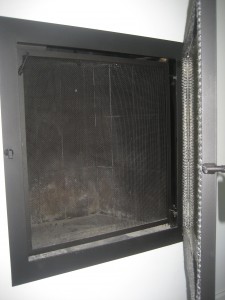 There are two sections to combustion venting: a prerequisite, which almost got us kicked out of the LEED for Homes program, and EQ 2.2 Enhanced Combustion Venting Measures, worth a maximum of two points. The prerequisite for basic combustion venting measures is as follows:
There are two sections to combustion venting: a prerequisite, which almost got us kicked out of the LEED for Homes program, and EQ 2.2 Enhanced Combustion Venting Measures, worth a maximum of two points. The prerequisite for basic combustion venting measures is as follows:
a. No unvented combustion appliances (e.g., decorative logs) are allowed.
b. A carbon nomoxide (CO) monitor must be installed on each floor.
c. All fireplaces and wood stoves must have doors.
d. Space and water heating equipment that involves combustion must meet one of the following:
i. it must be designed and installed with closed combustion (i.e., sealed supply air and exhaust ducting);
ii. it must be designed and installed with power-vented exhaust; or
iii. it must be located in a detached utility building or open-air facility.
All these measures are important for indoor air quality and human health, which can be adversely affect by leakage of exhaust gases into the home. So, we wanted to follow these prescriptions. How did we do? For (a): We do not have any decorative logs. Why would we? (b): We have CO detectors on every floor; it is required by Minnesota code anyway. (d): The only combustion equipment we have for space and water heating is a back-up gas boiler, which has a sealed exhaust to the outside.
It was part (c) where we initially had a problem. Our architect designed a Rumford fireplace for our home, a real wood fireplace. We had had a gas fireplace in our last home, and we did not like it. It smelled like gas. We could not roast marshmallows around it, because it was covered in glass. It did not seem real to us. Our architect introduced us to the Rumford fireplace, which is small and very efficient. According to the Rumford website,
Rumford fireplaces are tall and shallow to reflect more heat, and they have streamlined throats to eliminate turbulence and carry away the smoke with little loss of heated room air. Rumford fireplaces were common from 1796, when Count Rumford first wrote about them, until about 1850. Jefferson had them built at Monticello, and Thoreau listed them among the modern conveniences that everyone took for granted. There are still many original Rumford fireplaces – often buried behind newer renovations-throughout the country.
Cool, right? The problem is, the Rumford fireplace does not have a door. That’s the whole point! I thought maybe the USGBC would make an exception for the Rumford fireplace, since it is so small and efficiently designed. When I contacted our LEED for Homes Provider at the time, she emailed me this response: “A Rumford fireplace is not allowed in LEED for Homes. Sorry.” End of story! (We have since switched to a much more helpful and local provider, Building Knowledge, Inc.)
So, since this was a prerequisite for LEED, we had to get a door. It turned out that we were happy to have a door, because when it is shut nobody can blow the ashes around. When it is shut, I am more confident there is no back draft from the chimney. When it is shut, I feel the kids are safer. And we can open the door to roast marshmallows! We found a nice little door that fit well with our style. It cost us $1,763 to get it. That’s a lot more than we ever thought, and had we planned it ahead of time, it may have been easier and cheaper.
For the additional 2 points, we would have had to either install no fireplace, or design and install one according to certain confusing requirements outlined in the LEED for Homes Reference Manual. For ours, a masonry wood-burning fireplace, we would have had to buy a factory-built fireplace or insert that meets certain EPA standards for particulate matter emissions. Ours was built onsite as part of our home, so we are not eligible for points in this credit.
Indoor Environmental Quality points so far: 0
Cumulative points: 70.5
Additional points needed to get to Gold: 17.5
